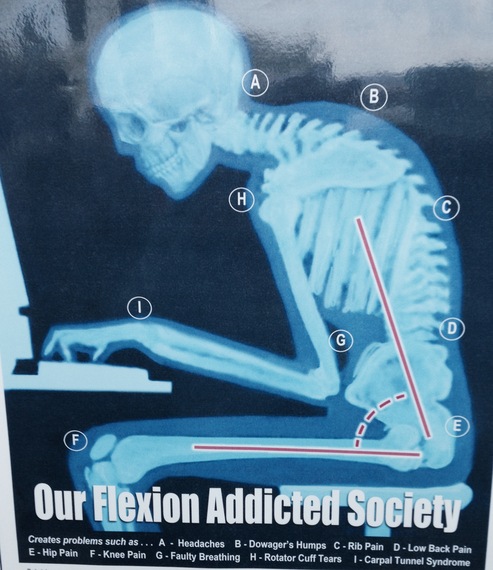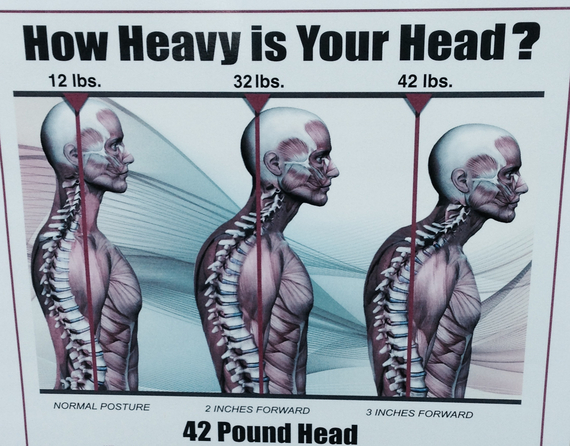Looking for a new job? There's a new position in the tech world, in Silicon Valley, Silicon Beach or anywhere else in the world. It's called the "flexion position." What's required to qualify? You have to be addicted to work. You must love a sedentary job that keeps you glued to your computer. You must be willing to have your hip muscles shorten and tighten as gravity pulls your body into a "C" like position. You must be willing to become at risk for developing neck, low back and hip pain, as well as, injuries like carpal tunnel syndrome from repetitive tasks.
Do You Look Like a "C"?
Does this look like you? Then you qualify. But do you want to? Our bodies live to be moving. So it's critical that we pay attention to our posture in and out of the chair (or bed, couch...) and our workplace ergonomics. Unfortunately, our brains re-learn this flexion, distorted, "C" posture as normal and we become unconscious to repeating it day, after day. And before you know it... you become a Flexion.
Of Course This Is Not Really a Job Description
But it is a description of a new addiction to work and our computers. And it isn't just the tech world. Many of my friends in other careers are experiencing the "flexion" addiction. I learned about this while sitting in my Chiropractor's office (Dr. Mary Trumpi) where I saw this poster by Freedom Pain institute and Erik Dalton (all the photos in this blog post are credited to him.) I was there to figure out why my back hurt and what I learned shocked me to the point I was impelled to share it with you so you can catch your own Flexion Addiction before it gets out of wack, and so do you. Believe me, the road to recovery is bumpy! It is doable and I'm proud to say I'm all better.... but know that I know...
So What Are the Health Related Issues With Flexioning?
According to the book written by Dr. Kapandji, Physiology of Joints, Vol 3, when we are sitting straight up, our head weighs 13 lbs. If we lean forward 2", it weights 32 lbs. and when we lean 3" forward our head weighs 42 lbs. This type of abnormal leverage from a forward-leaning head can pull the entire spinal column out of wack, decrease lung capacity by 30%, decrease inhalation and neurologically inhibit peristaltic action (resulting in having a difficult time going to the bathroom.)
But Wait, There's More...
It's no wonder the number of bulging, herniated and thinning disks is rising. And if that is not enough to scare you into walking straight, just like quitting smoking can reduce your risk of chronic disease, quitting sitting can also lengthen your lifespan. According to the National Center for Biotechnology Information American Cancer Society, sitting for long periods of time is associated with increased risk of disease, even if you maintain a healthy weight and don't smoke. In fact, if you are a couch potato, this applies to you, too. Too much sitting behind a desk, in front of the computer, game console, TV, in an automobile/train/plane may increase your risk of heart disease, obesity, diabetes, cancer and early death.
Risks may vary for men and women. Studies found women who sat for over 6 hours a day had a 34% higher risk of death compared with their peers who sit less than 3. For men, the increased risk was 17%. The average American sits down 7.7 hours / day. I know for most of my tech fellows, it's much more than this. One study found that even for active couch potatoes, 30 minutes of exercise a day is not enough to undo the effects of hours of sitting.
What Can a Flexion Do?
I'm only a Ph. D. in engineering and not an M.D. So this information is for general health and not medical advice. If you are experiencing this, you probably want to go see your doctor, your chiropractor, your orthopedic specialist, your stem cell doctor, your... But common sense says get up and get moving. Our bodies crave movement. Break up long periods of sitting by walking around when talking on the phone or schedule walking meetings. Set calendar reminders or your Fitbit-type devise to take a lap around the building. Move your wastebasket so you have to get up to throw things away. Make sure to get up and get a glass of water (we all need to drink 8 8 ounces of water a day {that's a half a gallon}, but do we?)
When on a plane, get up and stretch. Yeah the people next to you might be bothered, but its your life. Maybe show them this article or maybe they will have read it and go with you. And TV watchers, use commercials to stand up, touch your toes and repeat. And workplaces, use standing desks or ball chairs or encourage people to move. And set your computers up with the proper spacing.
What's the morale of the story? While I love my work in technology, we always need to be mindful of what it's doing to us. If you are in a business, people are your most valuable asset. Get moving and value them like they are just that.
@DrNatalie, Visionary and Paradigm Shifter, Digital Transformation and Design Thinker, Constellation Research
References:
1. Erik Dalton, Freedom Pain institute: erikdalton.com and Dr. Mary Trumpi, Santa Monica, CA: http://santamonicasportsmedicine.com
2. Neville Owen, et al, "Too Much Sitting: the Population Health Science of Sedentary Behavior." Exercise and Sports Sciences Reviews, July 2010. https://www.ncbi.nlm.nih.gov/pubmed/20577058
3. American Cancer Society Prevention Study, American Journal Of Epidemiology, "Leisure Time Spent Sitting in Relation to Total Mortality in a Prospective Cohort of U.S. Adults, May 14, 2014, http://aje.oxfordjournals.org/content/172/4/419.abstract
4. University of Vanderbilt, American Journal Of Epidemiology, "Amount of Time Spent Sedentary Behaviors in the U.S. 2003-2004. http://aje.oxfordjournals.org/content/167/7/875.long
5. VitaMin, Cigna and Tree of Life publication: 878142a 9/15
6. I. A. Kapandji, MD, Physiology of Joints, Vol 3: https://www.amazon.com/Physiology-Joints-III-I-Kapandji/dp/0702029599


